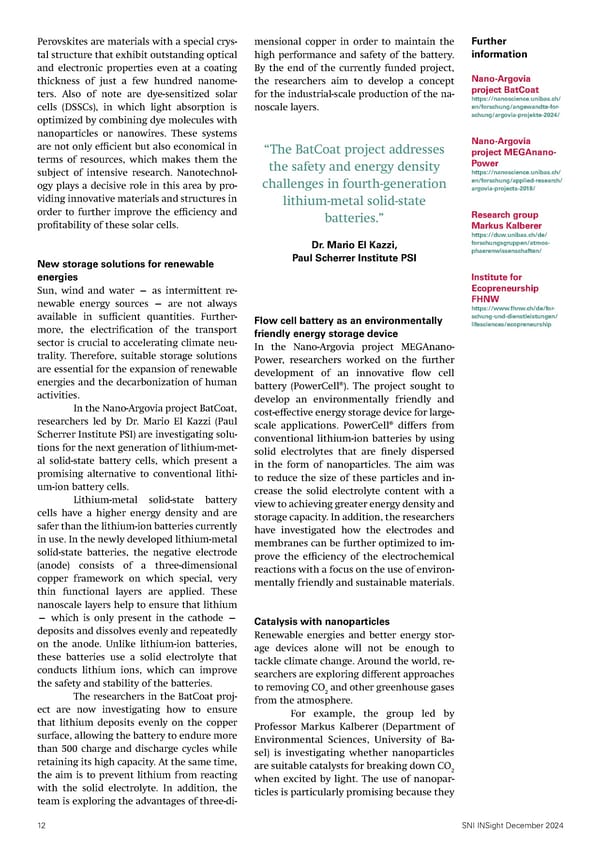Perovskites are materials with a special crys- mensional copper in order to maintain the Further tal structure that exhibit outstanding optical high performance and safety of the battery. information and electronic properties even at a coating By the end of the currently funded project, thickness of just a few hundred nanome- the researchers aim to develop a concept Nano-Argovia ters. Also of note are dye-sensitized solar for the industrial-scale production of the na- project BatCoat https://nanoscience.unibas.ch/ cells (DSSCs), in which light absorption is noscale layers. en/forschung/angewandte-for- optimized by combining dye molecules with schung/argovia-projekte-2024/ nanoparticles or nanowires. These systems Nano-Argovia are not only e昀케cient but also economical in “The BatCoat project addresses project MEGAnano- terms of resources, which makes them the the safety and energy density Power subject of intensive research. Nanotechnol- https://nanoscience.unibas.ch/ ogy plays a decisive role in this area by pro- challenges in fourth-generation en/forschung/applied-research/ argovia-projects-2018/ viding innovative materials and structures in lithium-metal solid-state order to further improve the e昀케ciency and batteries.” Research group pro昀椀tability of these solar cells. Markus Kalberer https://duw.unibas.ch/de/ Dr. Mario El Kazzi, forschungsgruppen/atmos- Paul Scherrer Institute PSI phaerenwissenschaften/ New storage solutions for renewable energies Institute for Sun, wind and water — as intermittent re- Ecopreneurship newable energy sources — are not always FHNW https://www.fhnw.ch/de/for- available in su昀케cient quantities. Further- Flow cell battery as an environmentally schung-und-dienstleistungen/ more, the electri昀椀cation of the transport lifesciences/ecopreneurship friendly energy storage device sector is crucial to accelerating climate neu- In the Nano-Argovia project MEGAnano- trality. Therefore, suitable storage solutions Power, researchers worked on the further are essential for the expansion of renewable development of an innovative 昀氀ow cell energies and the decarbonization of human battery (PowerCell®). The project sought to activities. develop an environmentally friendly and In the Nano-Argovia project BatCoat, cost-e昀昀ective energy storage device for large- researchers led by Dr. Mario El Kazzi (Paul scale applications. PowerCell® di昀昀ers from Scherrer Institute PSI) are investigating solu- conventional lithium-ion batteries by using tions for the next generation of lithium-met- solid electrolytes that are 昀椀nely dispersed al solid-state battery cells, which present a in the form of nanoparticles. The aim was promising alternative to conventional lithi- to reduce the size of these particles and in- um-ion battery cells. crease the solid electrolyte content with a Lithium-metal solid-state battery view to achieving greater energy density and cells have a higher energy density and are storage capacity. In addition, the researchers safer than the lithium-ion batteries currently have investigated how the electrodes and in use. In the newly developed lithium-metal membranes can be further optimized to im- solid-state batteries, the negative electrode prove the e昀케ciency of the electrochemical (anode) consists of a three-dimensional reactions with a focus on the use of environ- copper framework on which special, very mentally friendly and sustainable materials. thin functional layers are applied. These nanoscale layers help to ensure that lithium — which is only present in the cathode — Catalysis with nanoparticles deposits and dissolves evenly and repeatedly Renewable energies and better energy stor- on the anode. Unlike lithium-ion batteries, age devices alone will not be enough to these batteries use a solid electrolyte that tackle climate change. Around the world, re- conducts lithium ions, which can improve searchers are exploring di昀昀erent approaches the safety and stability of the batteries. to removing CO and other greenhouse gases The researchers in the BatCoat proj- 2 from the atmosphere. ect are now investigating how to ensure For example, the group led by that lithium deposits evenly on the copper Professor Markus Kalberer (Department of surface, allowing the battery to endure more Environmental Sciences, University of Ba- than 500 charge and discharge cycles while sel) is investigating whether nanoparticles retaining its high capacity. At the same time, are suitable catalysts for breaking down CO the aim is to prevent lithium from reacting 2 when excited by light. The use of nanopar- with the solid electrolyte. In addition, the ticles is particularly promising because they team is exploring the advantages of three-di- 12 SNI INSight December 2024
 SNI INSight December 2024 Page 11 Page 13
SNI INSight December 2024 Page 11 Page 13